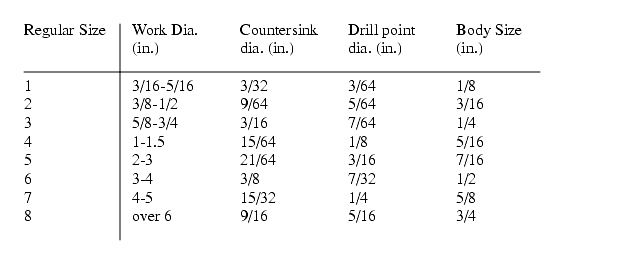4.1 Drilling
������������A very common operation that cuts cylindrical holes.
General type of drill presses in use are,
Sensitive - typically belt driven, and the bit is fed by hand. There are a limited choice of speeds. A bench top machine
Vertical or Pillar - has a heavy frame to support a wider range of work. The table height is adjustable, and power speeds and feeds are available.
Radial Arm - For very large and heavy work. The arm is power driven for the height location. The drilling head traverses the swinging arm. The workpiece remains stationary on the machine base, or work table. The machine spindle is moved to the location required.
More specialized drill presses are,
Multi Spindle - There are many spindles mounted on one head to allow many holes to be drilled simultaneously (e.g., up to 24)
Numerical Control Type - The machine can automatically change tooling with a turret or automatic tool changer. Speeds, feeds and table position are controlled using a computer program.
Counter Bores - Allows the head of cap screws to be sunk beneath a surface

Spot Face - Allows the head of a bolt to be sunk beneath the surface. This is basically a shallow counter bore.

Counter Sink - Allows counter sunk head screws to be sunk beneath a surface.

Center Drilling - Allows parts to be mounted between centers, on lathes typically.

Tapered Holes - these holes can be cut using reamers.

Threaded Holes - Taps can be used to add threads to holes

High tolerance finishes for holes can be made with boring or reaming.
4.1.1 Drill Bits
������������The twist drill does most of the cutting with the tip of the bit.
There are flutes to carry the chips up from the cutting edges to the top of the hole where they are cast off.
Some of the parts of a drill bit are diagramed below as viewed from the cutting tip of the drill,

Some other features of the drill bit are shown below for a side view of the drill bit,

Typical parameters for drill bits are,
Harder materials have higher point angles, soft materials have lower point angles.
The helix results in a positive cutting rake.
Drill bits are typically ground (by hand) until they are the desired shape. When done grinding, the lips should be the same length and at the same angle, otherwise and oversized hole may be produced.
Drill sizes are typically measured across the drill points with a micrometer


Some standard drill types are,
Some other types of drills used are,
- Core drills - a drill with a small helix, and 3 or 4 flutes. This is used for light drilling, such as opening holes in castings.
- High helix - When drilling a deep hole in a soft material these drills are used to help remove chips
- Straight fluted - Used to drill soft metals and plastics. The straight flutes prevent the bit from digging in.
- Centre drills - A drill with a small entry tip, and a widening profile. The result is a hole that has a conical shape on the outside, that may be used to mount the part between centres, or to act as a guide for a larger drill.
Typically an allowance of a third of the drill bit diameter is given for the tip of the drill.

4.1.2 Reamers
������������Reamers are a special class of drill. They are used after a hole has been drilled near to final size. The reamers is then used to remove a small quantity of material, and finish the hole with a good surface texture, roundness, and alignment.

These are often used to provide holes for bearings, parallel and taper dowels, and various fits with a shaft.
These are typically made of High Speed Steel, or with carbide tips.
The main body contains many straight and helical flutes. The tip does not contain any cutting edges.
- Taper Reamers - has a taper from one end to the other. These can be used in a spindle (tapered shank), or by hand (for a taper wrench).
Recommended allowances and speeds for reaming [Krar],

4.1.3 Boring
������������Boring is used for high quality finished.

In boring the tool can be rotated, or the work can be rotated.
4.1.4 Taps
������������Taps can use for both internal and external threads.
A typical set of hand taps consists of
There are flutes in the taps to help remove chips, to provide cutting edges, and channels for lubrication.
There are a number of sets of threads available,
To create one of these holes, we must first drill a hole that is slightly smaller. For example,

Some setups associated with taps are,
NF/NC Thread Tap Drill Sizes [Krar],

4.1.5 Process Parameters
������������The parameters for drilling are found in almost the same way as for lathes,

Typical high speed drill speeds are, [Krar]

Consider also the typical feeds for drilling, [Krar]

4.1.6 The mrr For Drilling
������������considering the parameters defined in the discussion of speeds and feeds, etc, the mrr is given below,
